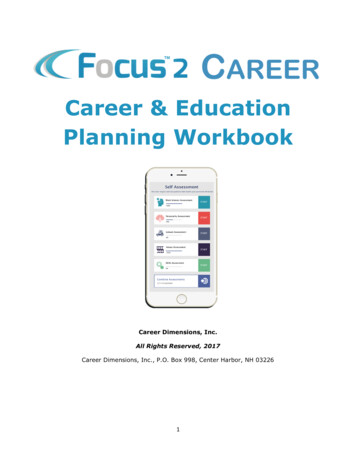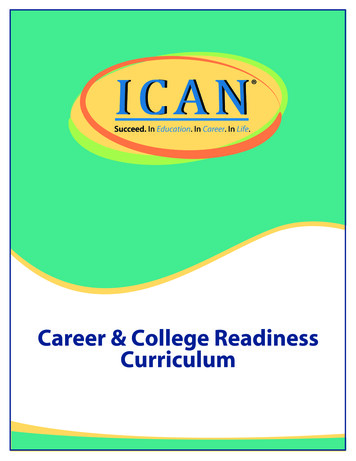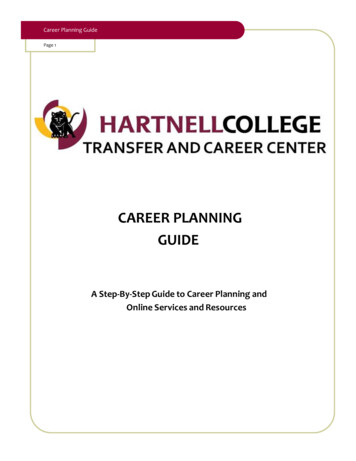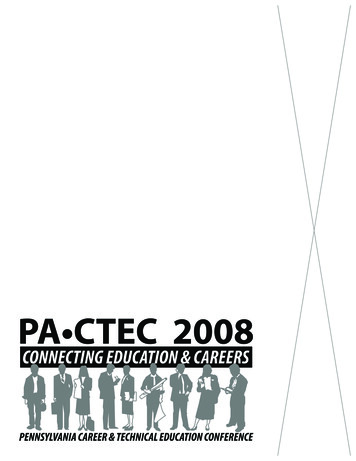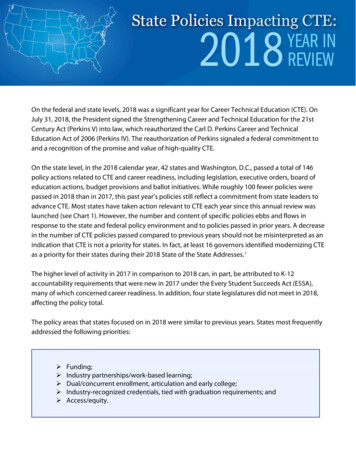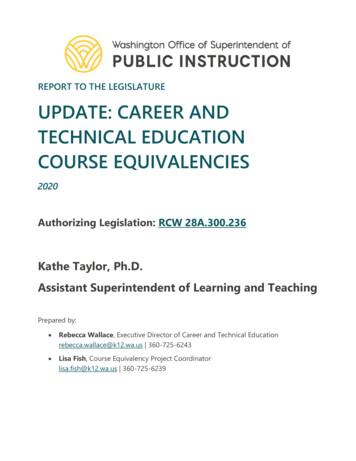
Transcription
REPORT TO THE LEGISLATUREUPDATE: CAREER ANDTECHNICAL EDUCATIONCOURSE EQUIVALENCIES2020Authorizing Legislation: RCW 28A.300.236Kathe Taylor, Ph.D.Assistant Superintendent of Learning and TeachingPrepared by: Rebecca Wallace, Executive Director of Career and Technical Educationrebecca.wallace@k12.wa.us 360-725-6243 Lisa Fish, Course Equivalency Project Coordinatorlisa.fish@k12.wa.us 360-725-6239
TABLE OF CONTENTSIntroduction . 4Development and Approval Process . 4Data Reporting Methodology . 4Update Status . 5Legislative Changes . 5CTE Equivalency Courses and Curriculum Frameworks . 6Table 1: Number of Statewide Equivalency Frameworks Available by Credit Type during 2019-20School Year. 6Table 2: Number of Frameworks Available by CTE Program Area 2019-20 . 7Course Offerings and Student Participation . 7Table 3: Statewide Equivalency Course Data Reported by School Districts . 7Data Limitations. 7Conclusion . 8Appendices . 9Appendix A: Current Statewide Equivalency Frameworks . 9Appendix B: CEDARS Manual . 9Appendix C: CTE Course Equivalencies Frameworks Request Form . 9Appendix D: CTE Course Equivalency Waiver . 9Appendix E: CTE Course Equivalency Certificate Templates. 9Legal Notice . 10Page 2
EXECUTIVE SUMMARYCareer and technical education (CTE) course equivalencies are courses that providestudents the opportunity to meet standard in core subject areas through CTE courses. Eachyear, school districts must report the annual number of students participating in stateapproved equivalency courses and the annual number of state-approved equivalencycredit courses offered (Revised Code of Washington [RCW] 28A.300.236). The Office ofSuperintendent of Public Instruction (OSPI) must then summarize the school districtinformation and submit a report to the Governor and the appropriate committees of theLegislature.This report reflects the data collected during the 2019–20 school year. The 2020–21 datawill be available at the close of the school year and will be shared in the 2021 report. Alldata should be considered baseline and preliminary.The number of high school state and local equivalency courses offered, and the number ofstudents enrolled in approved equivalency courses, increased during the 2019–20 schoolyear. Fewer state equivalency courses were offered through skill center campuses than inprevious years with 7 out of 14 skill center campuses submitting state equivalency data.By contrast, skill centers showed increased local equivalencies.Inconsistency in completion of submitted data suggests further technical assistance toschool districts and skill centers is needed to aid in accurate reporting. When schooldistricts correct and adjust submitted data, OSPI looks forward to reviewing and evaluatingthe new data reported.Page 3
INTRODUCTIONSchool districts have been able to adopt local career and technical education (CTE)equivalencies in all graduation requirement areas for more than 20 years, with stateequivalencies first made available prior to the 2015–16 school year. OSPI supports schooldistrict efforts to adopt course equivalencies for CTE courses. The use of CTE equivalenciesto achieve required graduation credit supports students’ flexibility and choice while theyare on their path to obtain a meaningful diploma. OSPI has created an approval anddevelopment process for state equivalencies that invites stakeholders to suggestdevelopment of additional course frameworks.Development and Approval ProcessStakeholders may access the State Career and Technical Education (CTE) CourseEquivalency Frameworks Request Form online to submit any course for consideration fordevelopment. Participants in the development process may vary dependent upon need;however, content experts in the academic, CTE, and industry-occupation aligned areas areinvited in the development and/or review of the course framework as technical workinggroup members. Refined draft frameworks are shared broadly for feedback and review andare posted on the OSPI website for public comment prior to being considered for finalapproval. Once approved by the State Superintendent, the framework document is postedon the website.The CTE Course State Equivalency Frameworks Process and Frameworks documentreleased in March 2020 describes the most recently approved frameworks. It is notablethat the authority to approve statewide equivalencies moved from the State Board ofEducation (SBE) to OSPI in 2018, and SBE approved 40 of the equivalency frameworkoptions reflected in this report.Statewide equivalency courses, as with all CTE courses, require approval by OSPI throughthe course approval process prior to implementation at the local school district level. Thisprocess requires school districts to clarify the course’s mandatory extended leadership(Career and Technical Student Organization [CTSO] or equivalency program of work),provide course and program level information, document the skills gap throughemployment demand data and approval of the course by the local advisory committee,and provide the course framework.Data Reporting MethodologySchool districts are required to submit equivalency data monthly and are able to updatedaily within their Student Information Systems (SIS). This information is reflected in theComprehensive Education Data and Research System (CEDARS) and reflects what has beenPage 4
reported by districts. The equivalency data report for the 2019–20 school year, runSeptember 2020, would contain complete Course Catalog courses for 2019–20. TheCEDARS manual may be found in Appendix B, which includes the data descriptors relatedto CTE Equivalency (Elements D12/D13).UPDATE STATUSPreviously approved Statewide Equivalency Frameworks have been reviewed and updatedto ensure compliance with the Americans with Disabilities Act, to reflect updated industrystandard alignment, and to ensure correct alignment to updated academic standards,when applicable. Selection and development of the newly developed course frameworksand in-process frameworks has been an intentional process aimed to: Ensure options for both comprehensive high schools and skill centers across the sixCTE programs; andProvide equivalency options for the content areas of mathematics, science, andEnglish language arts credits.During the 2019–20 school year, OSPI hired a Course Equivalency Project Coordinator whosupported four frameworks through the equivalency development and approval process.This included identifying the need for the course, drafting the framework, conveningtechnical working groups, refining and evaluating the course for academic alignment, andfinalizing the framework for review and consideration by the State Superintendent.These frameworks included Classification of Instructional Programs code (CIP): CIP 460000: Core Plus Construction,CIP: 150406: Robotics,CIP 512208: Systems Medicine, andCIP 030506: Forest Management.These frameworks were built with content and CTE educator experts, as well as keyindustry and postsecondary partners. State Superintendent Chris Reykdal approved thesefour courses on March 18, 2020.Legislative ChangesThe 2019 Legislature required school districts to provide access to a statewide equivalencyfrom a list of approved courses and to transcribe those courses as meeting academic creditand fulfilling a graduation requirement. Until September 1, 2021, districts must providehigh school students with the opportunity to access at least one CTE course that isconsidered a statewide equivalency course. On or after September 1, 2021, any statewideequivalency course offered by the district or assessed at a skill center will be offered forPage 5
academic credit. OSPI will continue to review data to look for opportunities to supportdistrict implementation of these adoption requirements.CTE Equivalency Courses and Curriculum FrameworksTable 1 lists the number of frameworks available in math, science, and English languagearts; and Table 2 identifies the number of frameworks available by CTE program area, asadministered and defined by OSPI.Table 1: Number of Statewide Equivalency Frameworks Available by Credit Typeduring the 2019–20 School YearType of Equivalency CreditNumber of FrameworksMathAlgebra 14Algebra 21Geometry3Credit Beyond Geometry1Statistics13rd Year Math1ScienceBiology or Lab Science5Lab Science15Life Science or Lab Science3Physics or Lab Science1Science4English Language ArtsEnglish1Combination3rd Year Math and Science1English and Math1English and Science1English, 3rd Year Math and Science2TOTAL45Source: CTE Statewide Course Equivalencies (updated July 2020)Page 6
Table 2: Number of Frameworks Available by CTE Program Area during the 2019–20School YearProgram AreaNumber of FrameworksAgriculture14Business & Marketing4Family & Consumer Science4Health Sciences5Skilled & Technical Sciences13Science, Technology, Engineering, and Mathematics (STEM)5TOTAL45Source: CTE Statewide Course Equivalencies (updated July 2020)Course Offerings and Student ParticipationTable 3 summarizes the current statewide equivalency course data as reported by schooldistricts in the CEDARS system.Table 3: Statewide Equivalency Course Data Reported by School DistrictsSchool YearHigh SchoolCourses OfferedSkill CenterCourses OfferedNumber urce: OSPI CEDARS CTE Equivalency ReportWhile there was a decline in the reported number of state equivalency courses offered byskill centers, OSPI identified several skill centers that did not report statewide equivalencieswithin the CEDARS system due to districts changing or updating SIS software. Anotherreason for data fluctuation is accuracy of reporting local and state equivalencies; forexample, some districts are still reporting a state equivalency as a local equivalency course.Data LimitationsThis report reflects the fourth year of available data, and there is an expected margin oferror in reporting data elements, which have expanded to differentiate between local andstate equivalency courses. OSPI will continue to provide targeted technical assistance toaddress data quality through the CTE and Student Information offices.Page 7
CONCLUSIONThe COVID-19 pandemic impacted the ability to provide in-person direct technicalassistance in the spring and summer, which likely affected data quality related to courseequivalency. However, there continues to be an increase in both the number of stateequivalency courses offered and number of students enrolled in those courses. Theincrease of additional state equivalency course options should continue to support growthin enrollment and course offerings.OSPI will continue to revise approved frameworks to correspond with updated academicand industry standards and refine frameworks to better support local implementation ofthe Washington State Learning Standards (WSLS). OSPI will also continue to engage in newframework development, professional learning and development, and improvement indata quality while partnering with local school districts’ administrators, teachers, andindustry partners.Page 8
APPENDICESAppendix A: Current Statewide Equivalency FrameworksThe current CTE frameworks in both Microsoft Word and PDF formats, and associatedequivalency credit are available on the OSPI website.Appendix B: CEDARS ManualThe current CEDARS manual, including data element descriptors is available on the OSPIwebsite. CTE Equivalency (Elements D12/D13).Appendix C: CTE Course Equivalencies FrameworksRequest FormThe current form to request consideration of statewide equivalency development isavailable on the OSPI website.Appendix D: CTE Course Equivalency WaiverThe current form to request consideration of a waiver from the provisions of RCW28A.230.015; requiring districts to provide high school students the opportunity to accessstate career and technical education statewide course equivalency courses is available onthe OSPI website.Appendix E: CTE Course Equivalency CertificateTemplatesThe current CTE Course Equivalency Certificate and State Equivalency Certificate templatesfrom the provisions of RCW 28A.230.097; the high school or school district shall also issueand keep record of course completion certificates that demonstrate that the career andtechnical courses were successfully completed as needed for industry certification, collegecredit, or pre-apprenticeship, as applicable. The certificate shall be part of the student'shigh school and beyond plan and is available on the OSPI website.Page 9
LEGAL NOTICEExcept where otherwise noted, this work by the Office of Superintendent of PublicInstruction is licensed under a Creative Commons Attribution License.Please make sure permission has been received to use all elements of this publication (images, charts,text, etc.) that are not created by OSPI staff, grantees, or contractors. This permission should bedisplayed as an attribution statement in the manner specified by the copyright holder. It should bemade clear that the element is one of the “except where otherwise noted” exceptions to the OSPI openlicense. For additional information, please visit the OSPI Interactive Copyright and Licensing Guide.OSPI provides equal access to all programs and services without discrimination based on sex, race,creed, religion, color, national origin, age, honorably discharged veteran or military status, sexualorientation including gender expression or identity, the presence of any sensory, mental, or physicaldisability, or the use of a trained dog guide or service animal by a person with a disability. Questionsand complaints of alleged discrimination should be directed to the Equity and Civil Rights Director at360-725-6162 or P.O. Box 47200 Olympia, WA 98504-7200.Download this material in PDF at OSPI Reports to the Legislature webpage. This material is availablein alternative format upon request. Contact the Resource Center at 888-595-3276, TTY 360-6643631. Please refer to this document number for quicker service: 21-0007.Chris Reykdal State SuperintendentOffice of Superintendent of Public InstructionOld Capitol Building P.O. Box 47200Olympia, WA 98504-7200Page 10
The CTE Course State Equivalency Frameworks Process and Frameworks document released in March 2020 describes the most recently approved frameworks. It is notable that the authority to approve statewide equivalencies moved from the State Board of Education (SBE) to OSPI in 2018, and SBE approved 40 of the equivalency framework .
